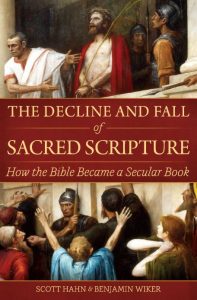By Scott Hahn and Benjamin Wiker
Scott Hahn is the founder and President of the St. Paul Center and the Fr. Michael Scanlan Professor of Biblical Theology and the New Evangelization at Franciscan University of Steubenville. He is the author or editor of over forty books on Scripture and theology.
Benjamin Wiker is a writer, teacher, lecturer, husband, and father of seven children. He is now a Professor of Political Science and Director of Human Life Studies at Franciscan University, and a Senior Fellow of Franciscan’s Veritas Center.

Why should anyone worry about the history of Scripture scholarship, especially reaching all the way back to the early fourteenth century?
The simple answer is that our peculiar situation today—in which priests, preachers, and people in the pews study the Bible as the inspired Word of God and academic Scripture scholars in universities study the Bible as an ancient book of mythology—is the result of the history of Scripture scholarship. We are searching for the reasons for this Great Divide, and that means searching for its ultimate origins.
It is a far greater divide than most lay people may realize. It’s no exaggeration to say that (setting aside a few outlier colleges and universities like Franciscan University of Steubenville) the last place one should go to study the Bible as the inspired Word of God is a Biblical Studies department at a university. Indeed, that’s the first place to go to have one’s Christian faith destroyed, for nearly the entire curriculum is defined by the assumption that the Bible is an entirely human artifact cobbled together in a “prescientific age.”
This assumption and the method built upon it define the academic study of the Bible today. Modern Scripture scholars assert that their treatment of the Bible is the result of the victories of modern science and rests upon their authority. A sign of this is that almost all histories of modern Scripture scholarship begin in the 1700s, the century after the publication of Isaac Newton’s Principia Mathematica in 1687. They then move on to nineteenth-century Germany, whose universities represent the intellectual paragon and pinnacle of the proper scholarly method that defines nearly all that follows in the twentieth and twenty-first centuries.
But if we are right, and the assumptions of modern Scripture scholarship can be traced back almost four centuries prior to Newton, then the effect would seem to precede the cause. If such is the case, there must be other, more fundamental, nonscientific (even “prescientific”) reasons for the assumptions of modern Scripture scholars and their consequent methods. While the history is quite complex, we believe that we have recovered one of the most important: the politicization of the Bible—that is, the bending of Scripture to very earthly, political ends, the fundamental assumption being that there are no other ends but those of this world, and these are purely material ends.
We have argued this thesis in great detail in our academic work, Politicizing the Bible: The Roots of Historical Criticism and the Secularization of Scripture, 1300–1700 (Crossroad, 2013). In our new work, The Decline and Fall of Sacred Scripture, we wish to set out those arguments for a more popular audience, adding new material and reflections that significantly strengthen and enrich the thesis and make it available to a wider readership.
Our goal in doing this is not primarily to “win” an academic argument, but to contribute to a critical revival of biblical scholarship that supports (rather than undermines) the Christian faith of priests, preachers, and people in the pews.
And in order to understand the politicization of the Bible, we must understand the historical critical method which has led to such much distrust.
What is historical criticism? What is meant by “critical” is definitive: “critical” refers to the skeptical attitude toward the supernatural that defines what can happen in history. If miracles are impossible, then Jesus couldn’t have cured lepers, walked on water, or risen from the dead; therefore, the historical-critical scholar must provide his or her own entirely natural account of what actually happened. This skeptical attitude began to exert cultural influence in the early 1500s, before the scientific revolution.
While many use the term historical-critical method to mean whatever kind of exegesis that flows from the critical assumption that supernatural beings and events cannot exist, technically speaking the historical-critical method refers to three specific academic approaches to the biblical text: source criticism, which developed in the late 1800s; form criticism, which developed in the 1920s; and redaction criticism, which developed after World War II. Source criticism attempts to argue for the existence of hypothetical literary documents that are alleged to be the real foundation of extant biblical texts; form criticism tries to make the case for hypothetical oral traditions and sources that are alleged to be the real foundation of biblical texts; and finally, redaction criticism focuses on some alleged editorial process that brought about the biblical texts.
There is a good reason why many simply associate these developments with the “critical” assumption that modern science has eliminated the supernatural: most academic scholars who engage in the use of source, form, or redaction criticism accept the historical-critical assumption uncritically, and make use of source, form, or redaction criticism accordingly.
But, we must stress, there is no intrinsic relationship between the “critical” assumption and the legitimate inquiry about preexisting literary documents or oral traditions, or about editorial processes. To take an important illustration, I (Scott Hahn) made extensive use of source criticism in my Kinship by Covenant to show how an understanding of the types of covenants in the Old Testament contributes to a much deeper grasp of the way that the overarching theme of covenant unites the Old and New Testament. My use of source criticism therefore illuminates rather than undermines the faith because canonical criticism (in the words of the Pontifical Biblical Commission) “aims to carry out the theological task of interpretation . . . within an explicit framework of faith: the Bible as a whole.”
Speaking more broadly, it is quite possible to analyze in the greatest scholarly detail biblical texts and manuscripts, and make intelligent judgments about their authenticity, integrity, and credibility without the assumption of skepticism about the supernatural inherent in historical criticism. In other words, we can subtract the peculiar identification of “criticism” with skepticism, and call such an approach simply the historical method. This method is critical in the original etymological sense, coming from the Greek word krinein, meaning “to judge.” Understood in this way, the historical method can make well-grounded judgments about the authorship and dating of texts, whether they are genuine or forged, whether there has been interpolation, and so on, all without adopting an attitude of complete skepticism about the possibility of the supernatural.
If we can take out the assumption of “critical,” defined by the rejection of the supernatural, then we can rightly ask, “How did this sense of ‘critical’ enter into biblical studies in the first place?” That is a rather long, complex story, one which (as we’ve noted above) begins in the early 1300s. That is the question we attempt to answer in our book The Decline and Fall of Sacred Scripture: How the Bible Became a Secular Book.
You Might Also Like
In The Decline and Fall of Sacred Scripture: How the Bible Became a Secular Book, authors Scott Hahn and Benjamin Wiker trace the various malformations of Scripture scholarship that have led to a devastating loss of trust in the inspired Word of God.
